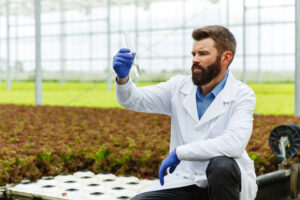The United Nations projects that the world population will reach 9.8 billion by 2050, a whopping 2.2 billion increase from now. This means we need to increase our crop production significantly to cater to the increasing number of people. Unfortunately, rapid urbanization and climate changes have claimed a significant share of farmlands. So today, there is an urgent need for increased food production for the growing population – with less land to grow. Let’s take a closer look at how big data and agricultural technology can help tackle this challenge. Soil data analytics is an excellent step in this direction.

How can Big Data help agriculture?
To solve the problems of increasing food demand and climate change, policymakers and industry leaders seek IoT, big data, analytics, and cloud computing assistance.
IoT devices assist in the first phase of this process: data collection. Sensors plugged into tractors and trucks, as well as in fields, soil, and plants, aid in collecting real-time data directly from the source.
Second, analysts integrate vast amounts of data collected with other information sources in the cloud, like weather and satellite data and pricing models, to understand the patterns.
Finally, these patterns and insights help in identifying and controlling the problem. They help pinpoint existing issues, like operational inefficiencies and problems with soil texture and quality and formulate predictive algorithms that can even send an alert before a problem occurs.
Top 4 use cases for Big Data on the farm
The scope for big data applications is enormous, and we’ve only started to explore just the tip of the iceberg. The ability to track physical items, collect real-time data, and forecast scenarios can be a real game changer in farming practices. Let’s look at a few use cases where big data can make a difference.
Feeding a growing population
This is one of the critical challenges that even governments are trying to solve. One way to achieve this is to increase the yield from existing farmlands.
Big data provides farmers with granular data on rainfall patterns, water cycles, fertilizer requirements, etc. This enables them to make intelligent decisions, such as what crops to plant for better profitability and when to harvest. The right choices ultimately improve farm yields.
Using pesticides ethically
The administration of pesticides has been a contentious issue due to its side effects on the ecosystem. However, big data allows farmers to manage this better by recommending what pesticides to apply, when, and by how much.
By monitoring it closely, farmers can adhere to government regulations and avoid the overuse of chemicals in food production. Moreover, this leads to increased profitability because crops don’t get destroyed by weeds and insects.
Optimizing farm equipment
Big iron companies like John Deere have integrated sensors in their farming equipment and deployed big data applications that will help better manage their fleet. For large farms, this level of monitoring can be a lifesaver as it lets users know of tractor availability, service due dates, and fuel refill alerts. In essence, this optimizes usage and ensures the long-term health of farm equipment.
Managing supply chain issues
McKinsey reports that a third of food produced for human consumption is unfortunately either lost or wasted every year. This is devastating since the industry struggles to bridge the gap between supply and demand. To address this, food delivery cycles from producer to the market need to be reduced. Big data can help achieve supply chain efficiencies by tracking and optimizing delivery truck routes.
The Cloud and the Future of Big Data in Agriculture
Success in farming has depended mainly on favorable natural forces, but not anymore. Combining cloud computing and big data has ensured that farmers have sufficient data points to make good decisions.
Cloud computing has democratized enormous computing power as data centers and storage are now available on a ‘pay-as-you-go’ model. This has made it possible to bring together knowledge repositories that contain data such as weather, irrigation practices, plant nutrient requirements, soil data analytics and several other farming techniques.
Cloud-based apps can guide farmers in adjusting their production based on market demand and improving their yield and profitability. Today, a farmer can micromanage farming and all its accompanying activities — even before planting crops, estimating the results is feasible by tweaking the variables involved.
Getting started with Big Data in agriculture
Big data can revolutionize the agricultural sector only by having a cloud-based ecosystem with the right tools and software to integrate various data sources. These tools should be able to consolidate data on climate, agronomy, water, farm equipment, supply chain, weeds, nutrients, and so much more to aid the farmer in making highly informed decisions.
If you are looking for help regarding soil data and its analysis, experts at SoilOptix® can help. Visit https://soiloptix.com/ for a detailed consultation.
